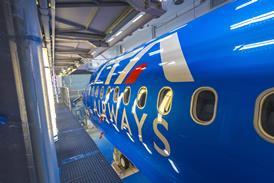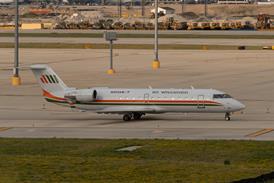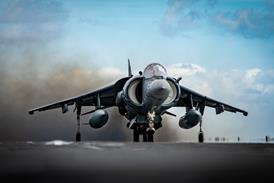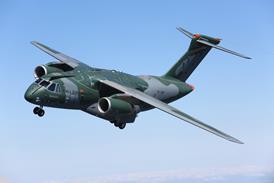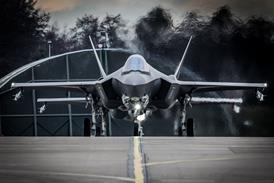Unmanned aircraft developer Rotor Technologies is working through regulatory approval of a remotely piloted helicopter based on Robinson Helicopter’s R44, with hopes of tapping into the aerial crop-dusting market.
The New Hampshire company, launched in 2021 by aerospace engineer Hector Xu, is developing the “R550”, an aircraft it says has more capability and costs less to operate in certain missions than stock R44s.
“We see a really bright future for unmanned Robinsons,” says Xu. “The safety and the efficiency and the cost benefits of doing it unmanned are a no-brainer.”
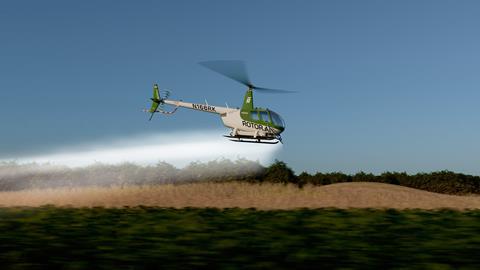
Rotor in 2022 completed first flight of an uncrewed prototype based on Robinson’s entry level R22 helicopter, then turned to develop its primary production product – the uncrewed, Lycoming IO-540-powered R550, which Rotor flew for the first time last year.
The firm is selling two R550 variants. The R550 Sprayhawk, priced new at $1.5 million and designed for crop dusting and other agricultural missions, has a 1,134kg (2,500lb) maximum gross weight and can carry 416 litres (110USgal) of spray liquid, nearly double the R44’s capacity, Rotor says. Sprayhawk can remain airborne for 50min, treat 97ha (240 acres) of cropland hourly and be programmed to fly automated spray patterns. Rotor says Sprayhawk will cost less to operate than R44s and other competing crop dusters.
Its other offering, the $1.35 million Airtruck, is an unmanned utility helicopter marketed for heavy lift and cargo transport that can carry a 500kg useful load. The aircraft are controlled by a ground-based pilot and intended to be operated within line of sight – or at ranges of roughly 8km (5 miles).
This year, Xu aims to have some “pre-certification” R550 Sprayhawks flying actual crop-dusting flights with customers.
Xu, who holds aerospace engineering degrees from the University of Cambridge and Massachusetts Institute of Technology, founded Rotor to address what he views as demand for the advanced remote-piloting technologies that will enable broader growth of the autonomous aircraft market.
As such, Rotor is not an aircraft developer but an autonomous aircraft system company. It has partnered with Robinson and is modifying R44s at its facility in Nashua, New Hampshire. Rotor developed software and flight control laws required for autonomous flight, and actuators and other hardware that manipulates aircraft control surfaces. “What’s hard about this is that the electric motors need to be very, very reliable,” Xu says, noting that pilots of traditional helicopters can take over if an autopilot fails.
“We don’t have that option,” he says. Failure of a component like an actuator “has the potential to take down the aircraft… Redundancy is a very important part of making these systems highly reliable”.
Rotor equips R550s with ADS-B, numerous cameras (including forward, tail and side cameras) and downward-sensing LIDAR (light detection and ranging), which aids in avoiding terrain and obstacles like electric wires.
“These technologies are borrowed from the automotive world,” says Xu. “Almost all LIDAR development has been funded and enabled by autonomous driving.”
Rotor also developed the systems that enable remote control, including communications technologies and “human-machine interfaces… that allow someone sitting on the ground, with a fairly low level of training… to be able to fly a very capable aircraft”, says Xu.
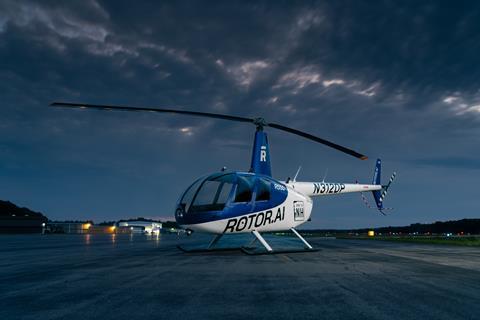
Other firms, including start-ups Xwing (now part of Joby Aviation) and Reliable Robotics, have also been developing autonomous and remote-piloting systems, though for fixed-wing commercial aircraft. And helicopter manufacturers like Airbus, Sikorsky and Bell have developed autonomous technologies for their products, with focus largely on defence and security applications. Various firms also sell small unmanned aircraft intended for crop dusting.
But Rotor is unique in offering a large, remotely piloted commercial helicopter intended specifically for the agricultural sector.
Xu declines to comment about Rotor’s finances other than to say the firm has “committed investors that want to see us… succeed”. Rotor employs about 35 people, most dedicated to engineering and product development.
“For the last year and a half, we’ve been taking that technology, making it better, and… turning a prototype into a product,” Xu says. “Our product development will continue, and certification efforts will continue into 2025.”
Xu also declines to predict when Federal Aviation Administration might approve the R550, citing the evolving nature of the agency’s unmanned aircraft regulations.
The FAA’s current drone rule, the Small Unmanned Aircraft Systems regulation, applies only to aircraft weighing less than 25kg (55lb).
Because the R550 far exceeds that limit, Rotor is seeking FAA approval through regulatory exemptions – including through an established pathway known as Section 44807 that is intended for larger drones. Rotor says R550s will also comply with new unmanned aircraft rules now being developed by the FAA.
“It’s coming sooner than you think,” Xu predicts of the R550’s FAA approval. “If you go look across the advanced air mobility ecosystem… I think we’re probably the closest to having aircraft delivered and operating and certified”.


